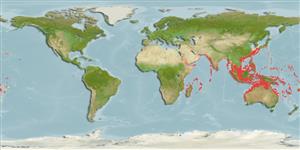>
Eupercaria/misc (Various families in series Eupercaria) >
Lutjanidae (Snappers) > Apsilinae
Etymology: Paracaesio: Greek, para = the side of + Latin, caesium = bluish grey (Ref. 45335).
More on author: Bleeker.
Environment: milieu / climate zone / depth range / distribution range
Ecologie
marien rifbewoner; diepte 5 - 250 m (Ref. 86942). Tropical; 35°N - 35°S, 37°E - 169°W (Ref. 55)
Indo-Pacific: East Africa to the Austral Islands, north to southern Japan, south to southeastern Australia. Paracaesio xanthura, a complex of variable populations, may compose a single or two (or more) species. Paracaesio pedleyi, from Lord Howe Island, Middleton Reef, and eastern Australian waters, is included here with some reservation (Ref. 9821).
Grootte / Gewicht / Leeftijd
Maturity: Lm ? range ? - ? cm
Max length : 50.0 cm TL mannelijk / geslacht onbekend; (Ref. 5484)
Dorsale stekels (totaal): 10; Dorsale zachte stralen (totaal): 10-11; Anale stekels 3; Anale zachte stralen: 8 - 9. This species is distinguished by the following characters: body relatively deep and laterally compressed, greatest body depth 2.5-2.8 in SL; interorbital region convex; mouth terminal, jaws about equal; anterior end of upper lip without a thick fleshy protrusion; maxilla with or without scales and without longitudinal ridges; teeth in jaws caniniform to villiform; gill rakers of first gill arch 5-11 + 18-20; soft rays of dorsal fin usually 10, in anal fin 8; lateral line scales 70-72; caudal fin forked. Colour bright blue; broad yellow band over most of dorsal half of body, including most of caudal pedincle fin (Ref. 9821, 90102).
Adults occur over rocky bottoms, sometimes forming large schools. They feed largely on zooplankton (Ref. 30573). Caught mainly with handlines and bottom longlines and marketed fresh or frozen (Ref. 9821).
Levenscyclus en paargedrag
Maturiteit | Voortplanting | Paaien | Eieren | Fecunditeit | Larven
Allen, G.R., 1985. FAO Species Catalogue. Vol. 6. Snappers of the world. An annotated and illustrated catalogue of lutjanid species known to date. FAO Fish. Synop. 125(6):208 p. Rome: FAO. (Ref. 55)
Status op de Rode Lijst van het IUCN (Ref. 130435)
Gevaar voor de mens
Harmless
Gebruik door de mens
Visserij: commercieel
Meer informatie
Lokale namenSynoniemenMetabolismePredatorenEcotoxicologieVoortplantingMaturiteitPaaienPaaiaggregatiesFecunditeitEierenOntwikkeling van de eieren
ReferentiesAquacultuurAquacultuurprofielKweeklijnenGeneticaElectrophoresesErfelijkheidZiektesVerwerkingNutrientsMassaconversie
Tools
Speciale rapporten
Download XML
Internetbronnen
Estimates based on models
Preferred temperature (Ref.
123201): 19.9 - 28.3, mean 26.5 °C (based on 1214 cells).
Fylogenetische diversiteitsindex (Ref.
82804): PD
50 = 0.5039 [Uniqueness, from 0.5 = low to 2.0 = high].
Bayesian length-weight: a=0.01905 (0.01031 - 0.03520), b=3.08 (2.91 - 3.25), in cm total length, based on LWR estimates for this species & (Sub)family-body (Ref.
93245).
Trofisch niveau (Ref.
69278): 3.4 ±0.45 se; based on food items.
Weerstandsvermogen (Ref.
120179): Gemiddeld, minimale populatieverdubbelingstijd 1,4-4,4 jaar (Preliminary K or Fecundity.).
Fishing Vulnerability (Ref.
59153): Moderate vulnerability (40 of 100).
Nutrients (Ref.
124155): Calcium = 35.2 [20.5, 63.3] mg/100g; Iron = 0.611 [0.323, 0.987] mg/100g; Protein = 18.6 [16.7, 20.3] %; Omega3 = 0.152 [0.096, 0.241] g/100g; Selenium = 46.7 [28.3, 84.0] μg/100g; VitaminA = 105 [37, 345] μg/100g; Zinc = 0.993 [0.700, 1.369] mg/100g (wet weight);
